Early Power Transmission
1917 - Transmission Line between Power Plant No. 1 and Los Angeles
The San Francisquito Power Plant No. 1 was placed in service in 1917 and energy was delivered to Los Angeles over a newly constructed 115 kV transmission line. The new lines ran from Power Plant No. 1 to the Olive Switching Station and then to the Central Receiving Station in the city (now Receiving Station A).
The Los Angeles Bureau of Power and Light sold its excess San Francisquito generated power to Pasadena over two newly constructed 34 kV lines between the two cities.
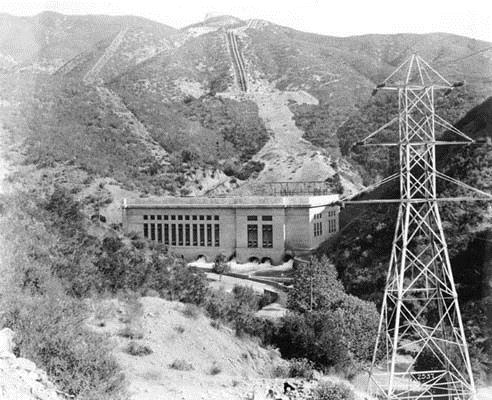 |
115 kV transmission tower standing in front of Power Plant No. 1
|
| Power Plant #1 (1928)* |
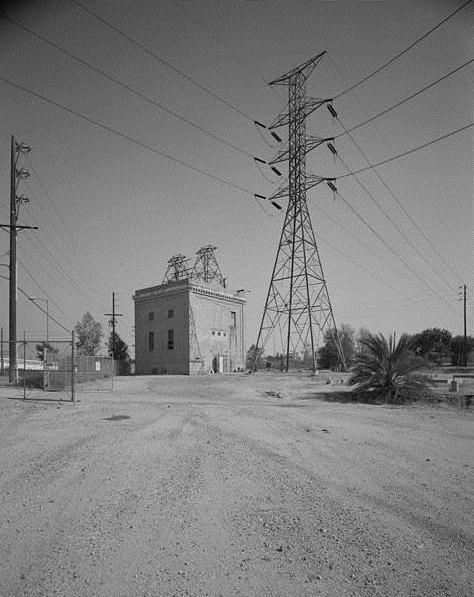 |
The Olive Switching Station was constructed between 1916 and 1917 at the mid-point of the 115 kilovolt (kV) transmission line from San Francisquito Power Plant No. 1 to the central receiving station in the city (now Receiving Station A).**
|
Background
The Olive Switching Station is the oldest such facility of the LA Department of Water and Power. It was a key element of the initial power development along the route of the Los Angeles Aqueduct. The station ensured the reliability of the system by allowing a section of any circuit on which trouble developed to be cut out without affecting service. The station remains vital to the operation of the San Francisquito Power Plants No. 1 and No. 2 as well as the facilities that bring water from the Owens Valley and Mono Basins to Los Angeles.
Early Transmission Line Construction
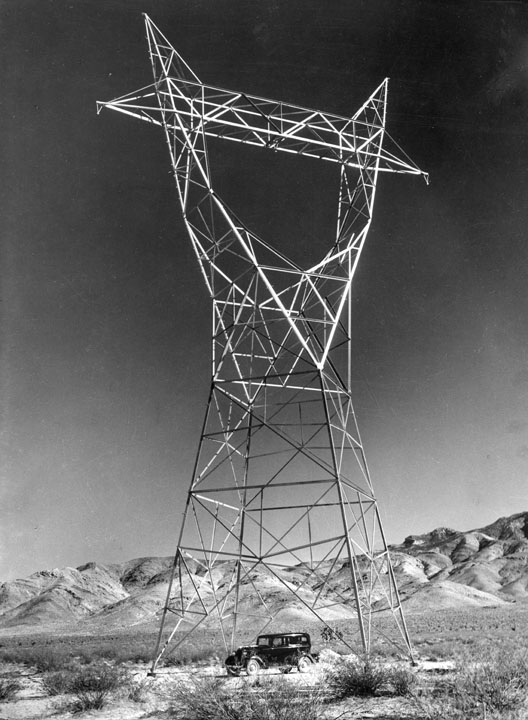 |
(1933)* - View of a single electric power transmission tower and line located in a scrub and low hill area. A single car sits directly under the tower.
|
Historical Notes The above tower was erected on the desert at a point near Kingston construction camp of the Bureau of Power and Light. It was the first of the 2423 single circuit steel towers that were built along the 270 mile transmission line extending from the Boulder Canyon Project to Los Angeles. Its overall height is 109 feet. * |
Construction of the Boulder Dam-LA Transmission Line
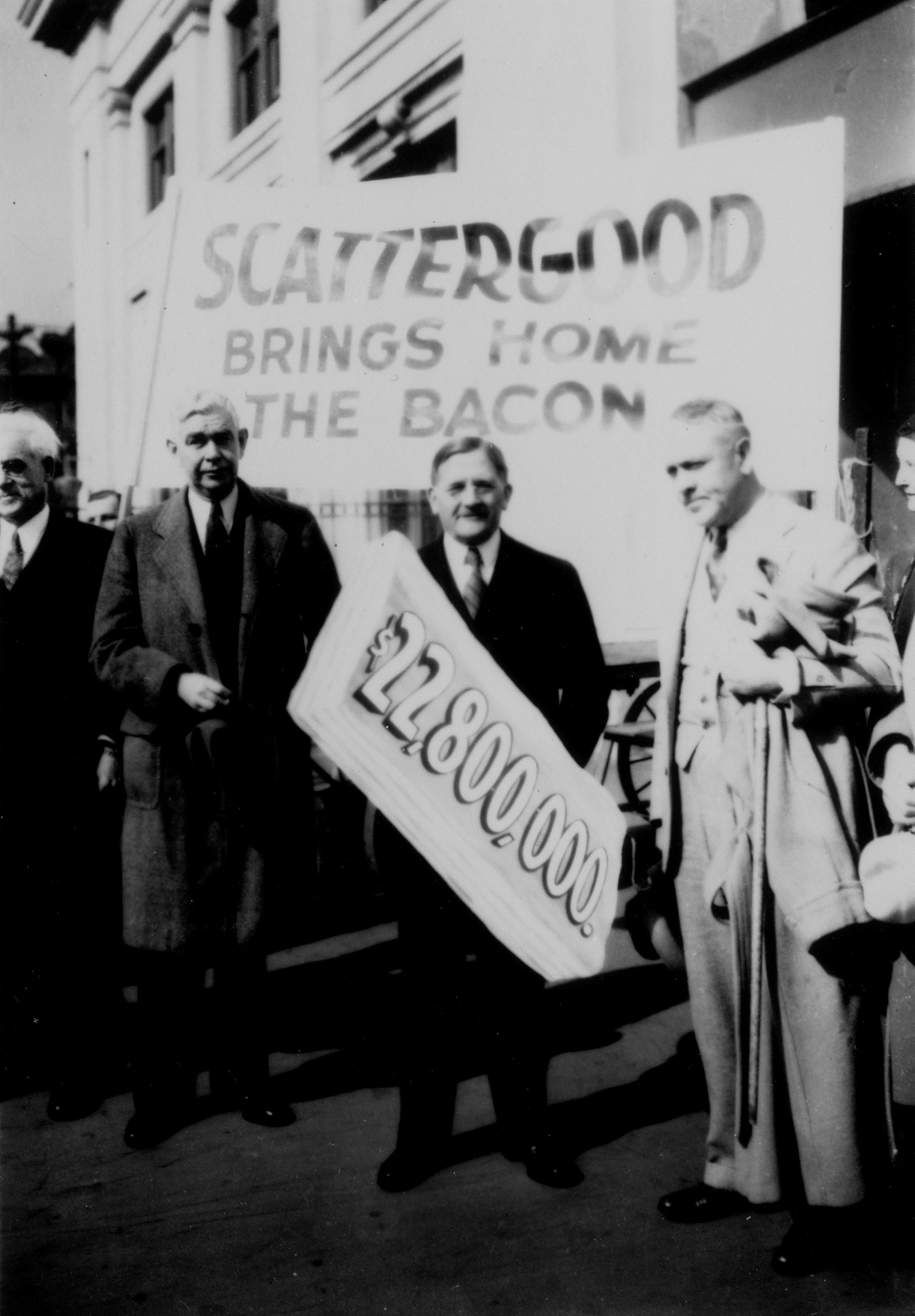 |
(1933)* - Scattergood 'Brings Home the Bacon'
In 1933 Ezra Scattergood travelled to Washington to borrow money for the construction of the Boulder Dam-LA Transmission Line. He was successful in obtaining a 10-year federal loan for $22,799,000. This enabled The Bureau of Power and Light to construct the historic 266 mile transmission line that brought Boulder Dam power to Los Angeles. (One year later, LA voters approved a bond measure to refinance the original 10-year loan to a 40-year loan.)
|
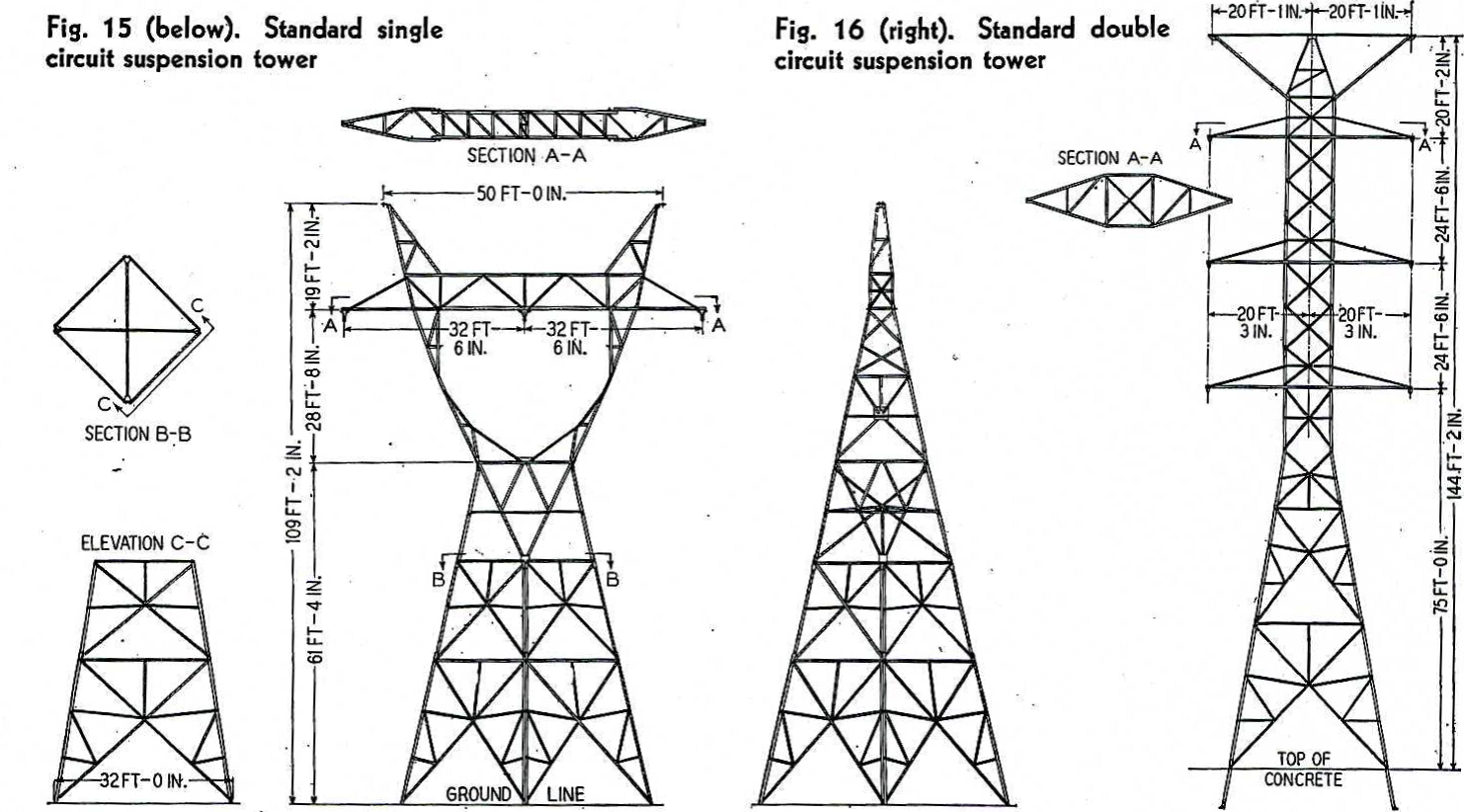 |
|
| New Transmission Tower Design for the Boulder Dam-LA Transmission Line (1935)^^ |
The Boulder-LA Transmission lines were constructed by the Bureau of Power and Light between 1933 and 1936. The lines consisted of two rows of towers 109-feet high and spaced 800 to 1,000 feet apart, at the time the largest in the world. They were built to carry 287,000-volt conductors a distance of 226 miles from the Boulder power plant to El Cajon Pass. From there, single towers 144-feet in height carried the circuits the remaining 40-miles to Los Angeles.^
| Click HERE for the Boulder Dam-LA Transmission Line Engineering Paper by E. F. Scattergood, presented to the American Institute of Electrical Engineers in 1935. |
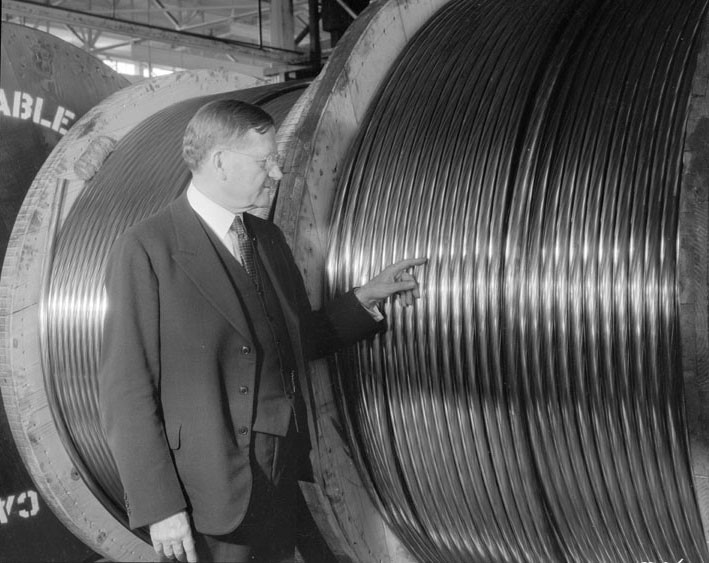 |
|
| (ca. 1933)* - E. F. Scattergood viewing the manufacturing of cable for the Boulder Line. |
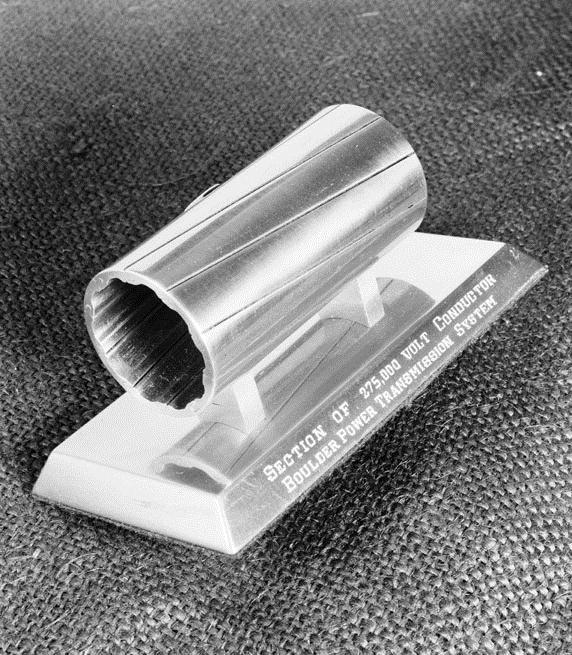 |
Section of the 275,000 volt conductor used on Boulder line - Boulder Power Transmission System
|
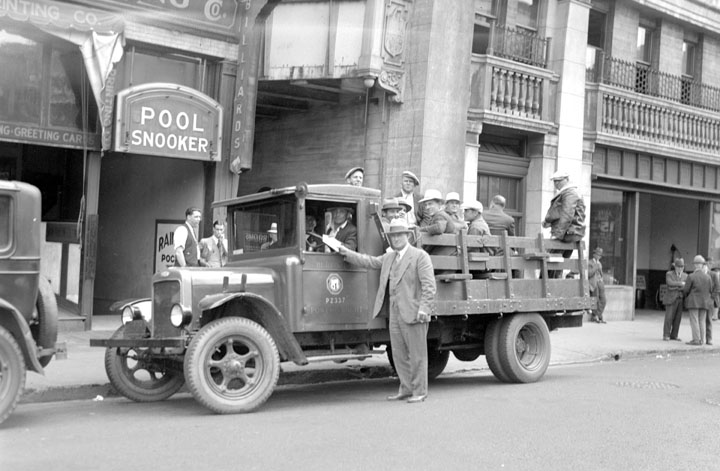 |
|
| (1933)* - First squad of transmission line workers leaving from Power Bureau offices at 218 South Hill Street, June, 1933. At the peak of activity, more than 1,600 men were employed on the 266-mile project. |
Historical Notes Early in June, 1933, the first fleet of trucks carrying men and materials got under way, headed for the desert area north of San Bernardino where the first Boulder transmission line construction camp was to be erected. Braving the desert’s scorching heat, these intrepid workers immediately set to work erecting portable shelters and drilling water wells in preparation for hundreds of other employees who soon would follow.*^ |
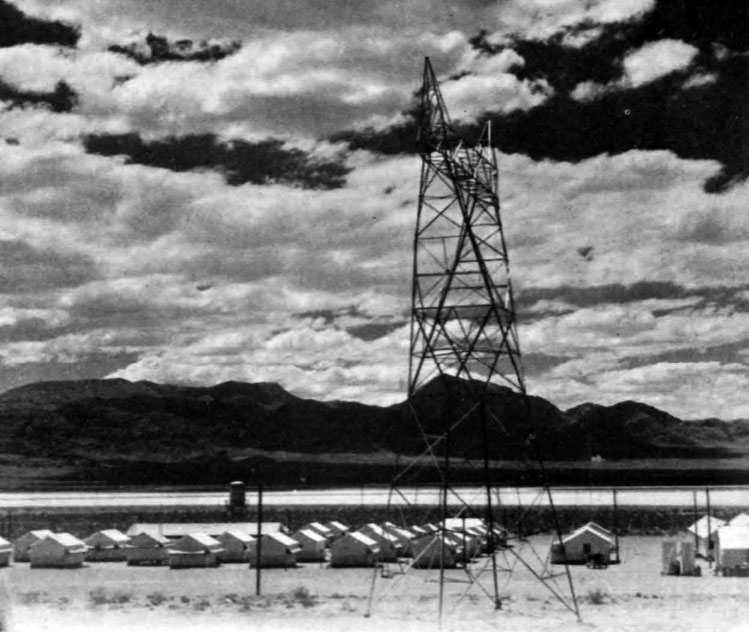 |
|
| (1933)* - Jean Camp, one of seven construction camps erected along the transmission line route. |
Historical Notes Boulder transmission line construction camps were built at Boulder City, Jean, Kingston Valley, Silver Lake, Harvard, Victorville and Cozy Dell, each location in the approximate center of the single circuit construction section of the same name. The camps had sleeping accommodations for 150 men and kitchen and dining room facilities for 200. Each one was virtually a small town with its own water supply, electric lighting system, hospital, bath houses, butane gas heating system, warehouse and repair shops. At the peak of activities, about 1,600 men were employed on the project.*^ |
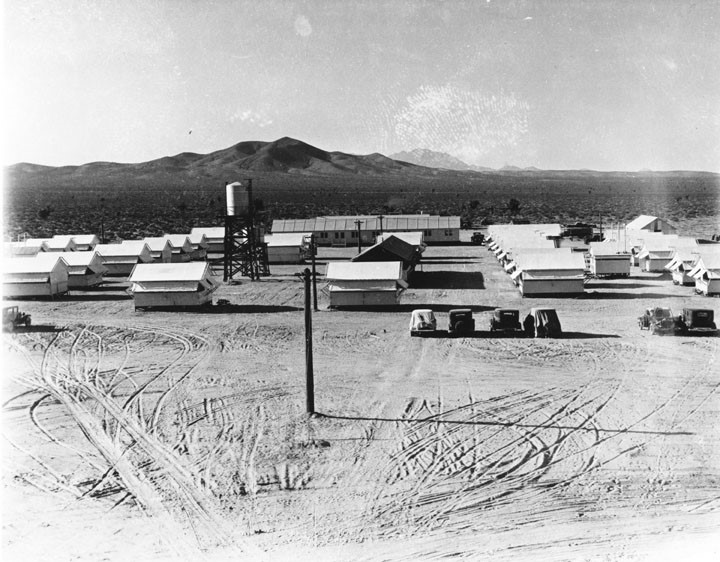 |
|
| (1933)* – View showing Camp Kingston with Shadow Mountain in background. |
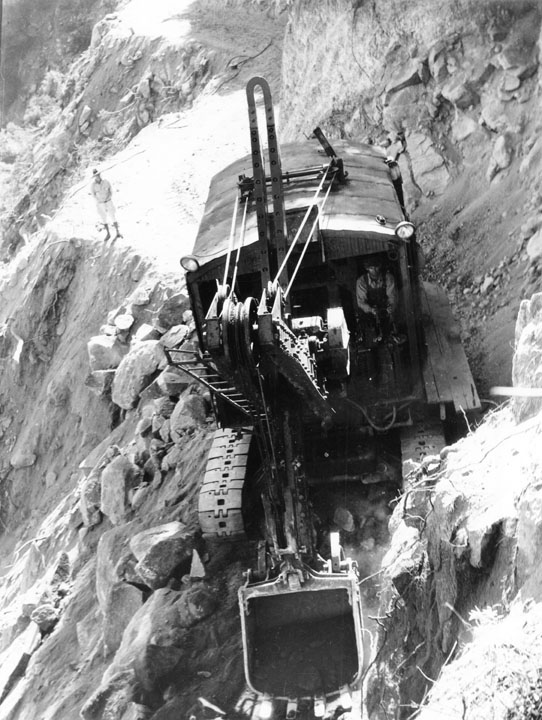 |
|
| (1934)* - Huge tractor shovels, operated by 'diesel' engines, used for road construction in the mountainous Cozy Dell sector. The shovels are of 1 1/2 cubic yards capacity and are a part of the equipment used for the construction of the Boulder Dam transmission line. |
Historical Notes Road building was an important preliminary to actual line construction work, 270 miles being laid out over desert stretches, where gravel ballasting was necessary, and mountain passes where roads in many spots had to be blasted out of solid rock. All construction material was hauled over these roads which later were used for patrolling.*^ |
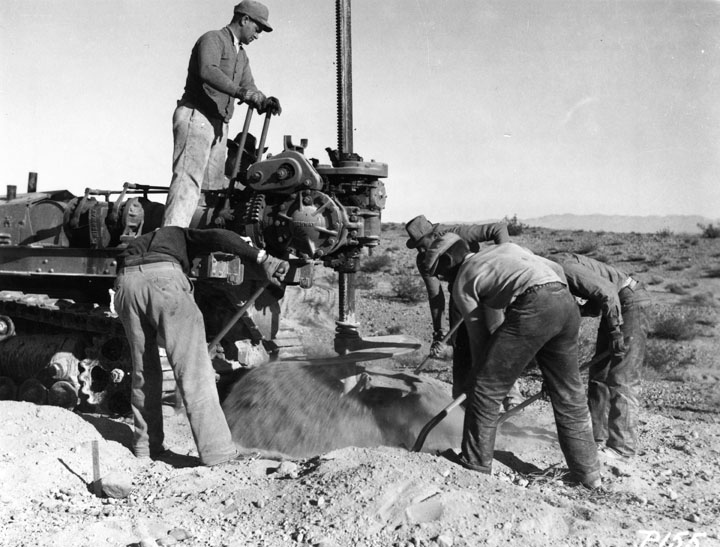 |
|
| (1934)* - View showing a crew boring a hole for the tower footing. |
Historical Notes In erecting the 2,695 steel towers, first the four footing excavations were dug, in most instances by an earth boring machine. In some mountain sections the footings had to be excavated by hand from solid rock. Tower stubs then were placed in the footings in a bed of reinforced concrete.*^ |
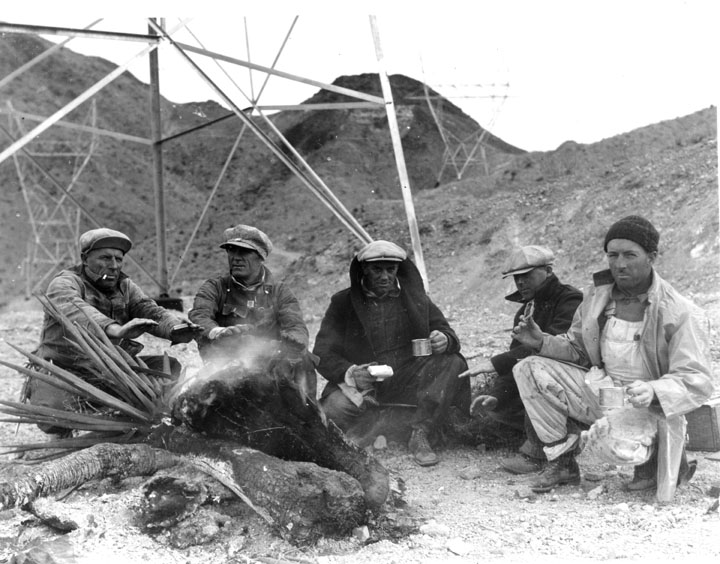 |
|
| (December 1934)* - Transmission line crew keeping warm at lunch time at the base of a tower about 8 miles east of Jean camp on the Boulder Dam transmission line project. |
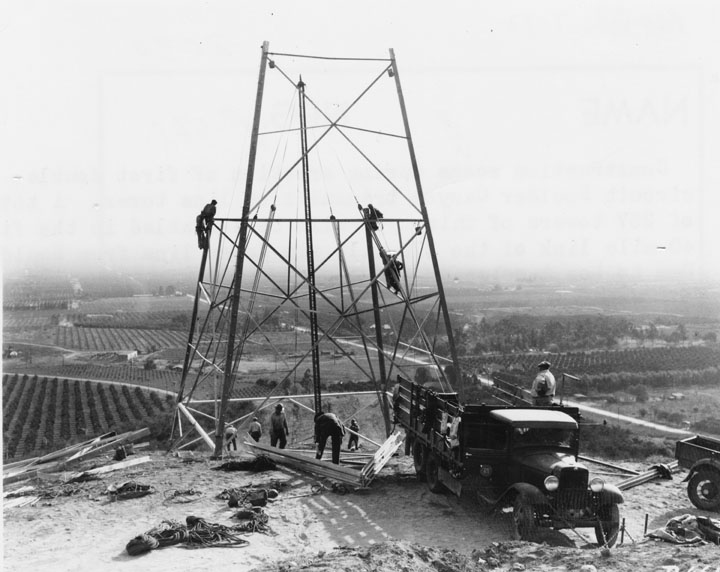 |
|
| (1935)* - Construction scene during erection of first double-circuit Boulder Canyon transmission line tower. A total of 257 towers of this type will be assembled in the final 40 mile link of the 270 mile power line from Boulder Dam to Los Angeles |
Historical Notes Tower erection was handled by three separate gangs. First was the assembly gang which assembled the steel parts into pre-determined units. Next came the erectors who erected the tower and installed all bolts. They were followed by the checking gang which checked all tower parts, tightened bolts and installed locknuts and turned in a final erection report.*^ |
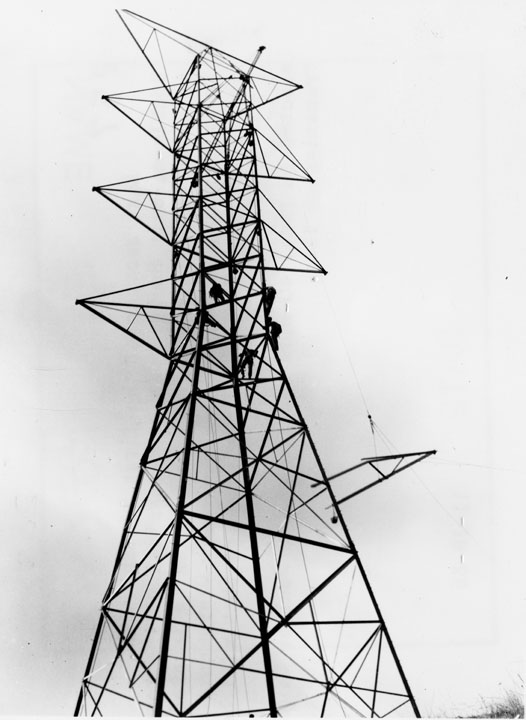 |
|
| (1935)* - Last section of the first 144 foot high, double-circuit Boulder Canyon transmission line tower is shown being lifted into place. Tower is located in vicinity of Mountain Avenue, near Claremont, and is one of 257 double-circuit towers that will be erected on final 40 mile section of the Boulder Canyon transmission line |
Historical Notes Weights varied from 9 ½ tons for the standard single circuit tower to 13 tons for the standard double circuit tower. Angle and deadened types were considerably heavier. Many of the single circuit towers were erected in from four to five hours; double circuit towers in about 10 hours.*^ |
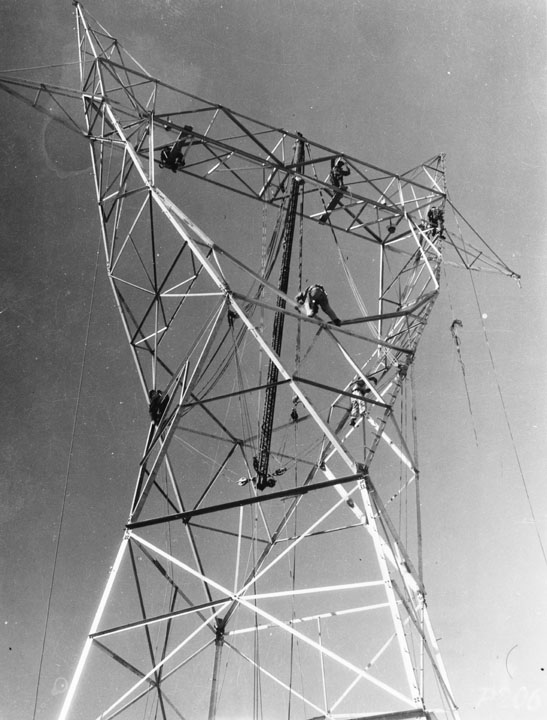 |
|
| (1935)* - Close-up view showing a crew erecting one of the Boulder transmission towers. |
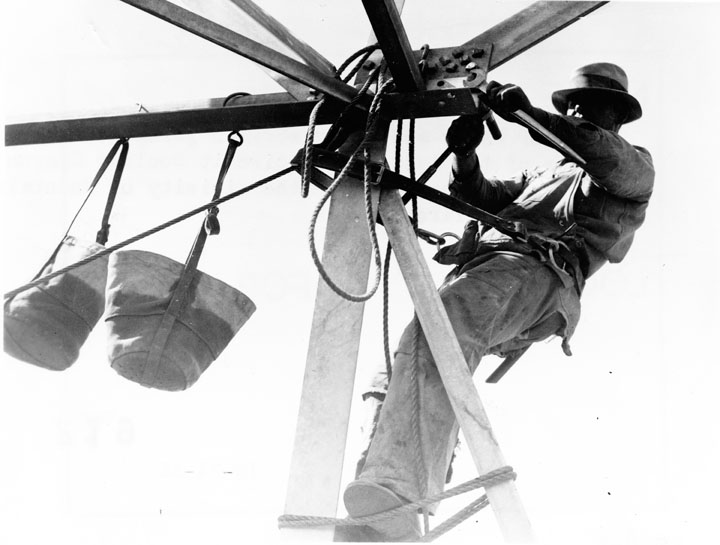 |
|
| (October 1935)* - Department of Water and Power workman joining sections of the last single-circuit Boulder Canyon transmission line tower in the vicinity of Mountain Avenue, near Claremont. |
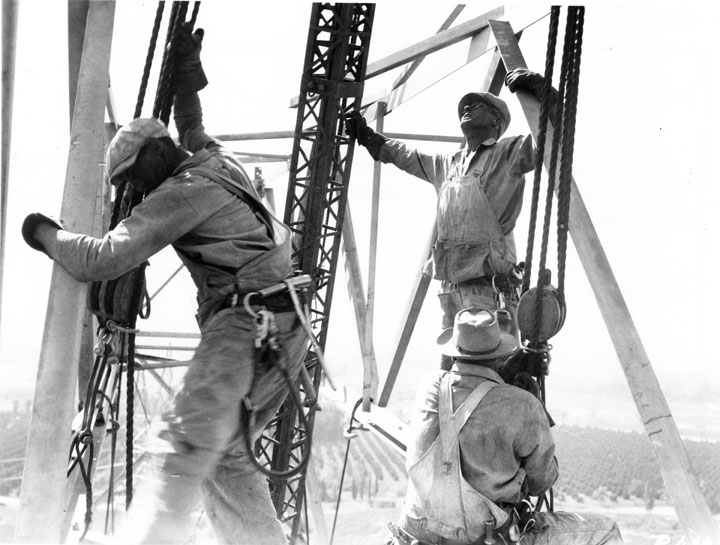 |
|
| (October 24, 1935)* - A construction scene at the last single-circuit tower of the Boulder Canyon transmission line near Claremont. |
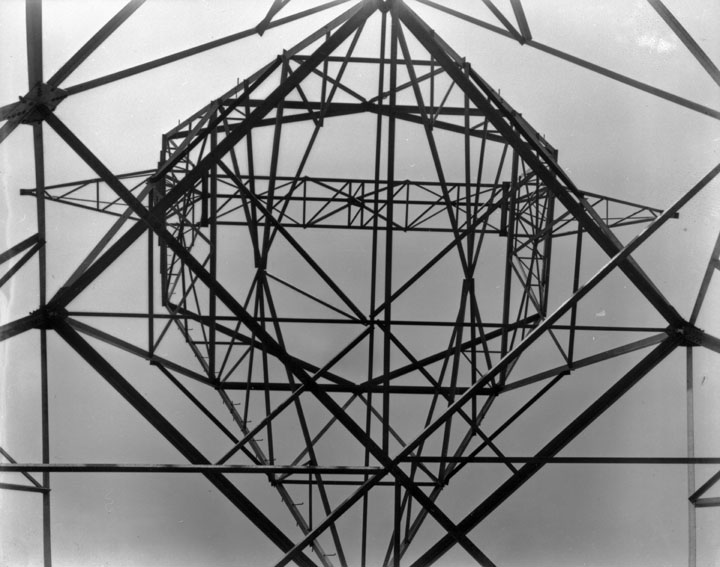 |
|
| (1935)* - Looking directly up toward the top of a completed Boulder transmission tower. |
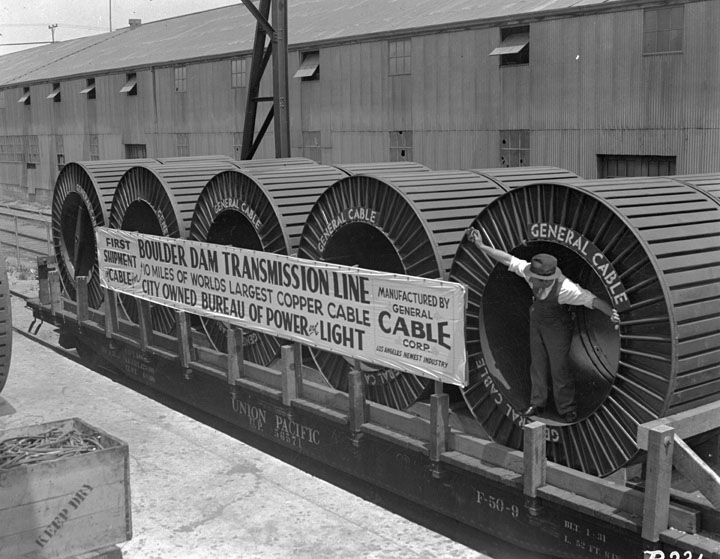 |
|
| (1934)* - First shipment of hollow copper conductor from new plant built in Los Angeles by General Cable Corp. was made May 1934. The ten reels shown loaded on flat car comprise a load of 50 tons. Each reel is wound with a mile of cable, 1620 miles being required for the completed transmission line. |
Historical Notes In total, 1,620 miles of the newly designed hollow copper conductor cable was used on the original 270 miles of Boulder line, weighing 6,727 tons.*^ |
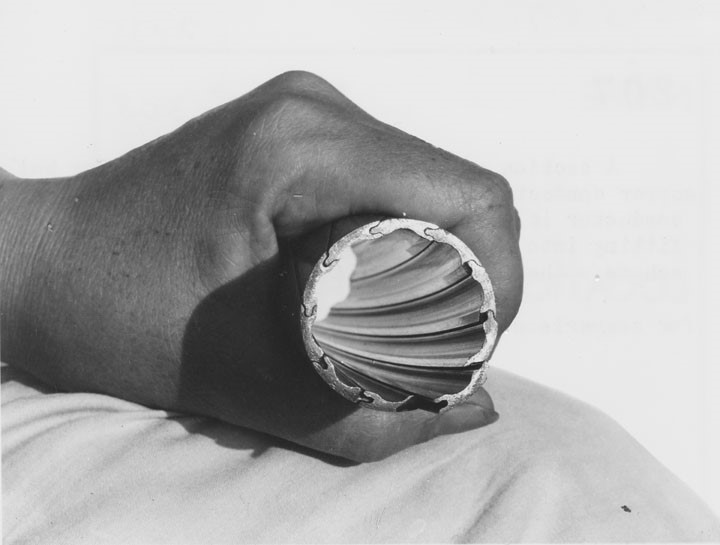 |
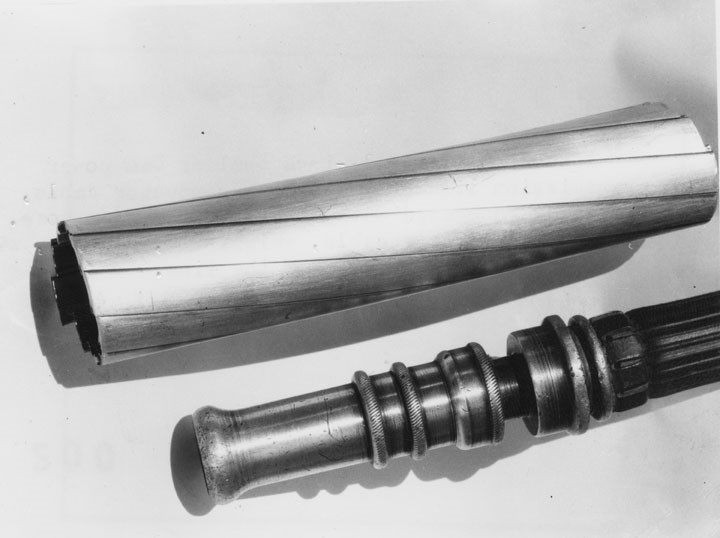 |
|
| (1930s)* - Cross-section view of the hollow copper conductor used on the Boulder transmission line. | (1930s)* - View showing the Boulder hollow copper conductor as compared with a standard garden hose. |
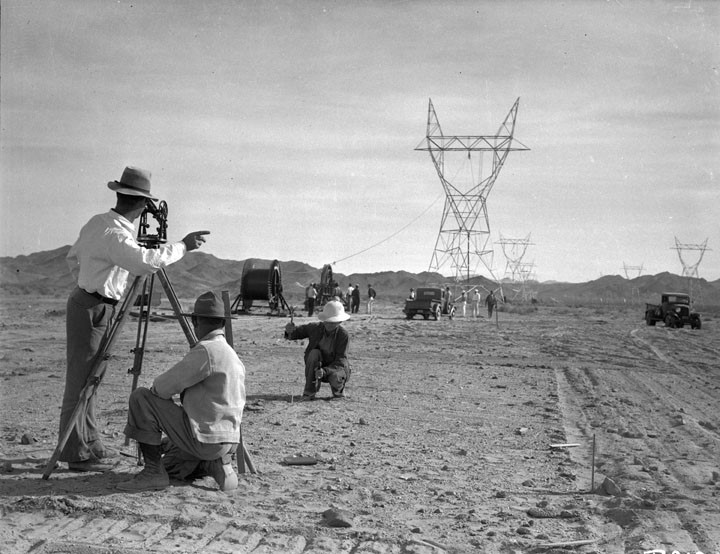 |
|
| (1934)* - Site of Silver Lake switching station with surveyors laying out construction lines. This station and one at Victorville divided the 270-mile power line into three sections for efficiency of operations. |
Historical Notes Approximately 1,600 miles of 1.4-inch diameter hollow copper conductor were strung, many special devices being designed by Power Bureau engineers to facilitate the work and prevent the cable from being scratched or kinked. Two steel ground wires were strung along the tips of each tower. These were connected through the tower steel to lines of counterpoise buried on each side of the tower line and connected by cross ties. This wire was placed by a counterpoise plow, also designed by Bureau engineers, which automatically dug the trench and laid the wire.*^ |
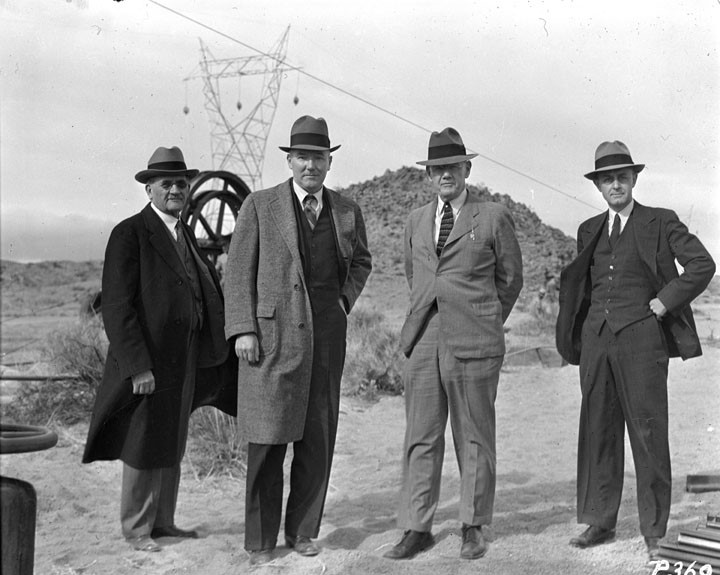 |
|
| (ca. 1934)* - Taken during construction of Boulder line in the mid 1930's - left to right: E. F. Scattergood, ?, ?, Clyde Erett. |
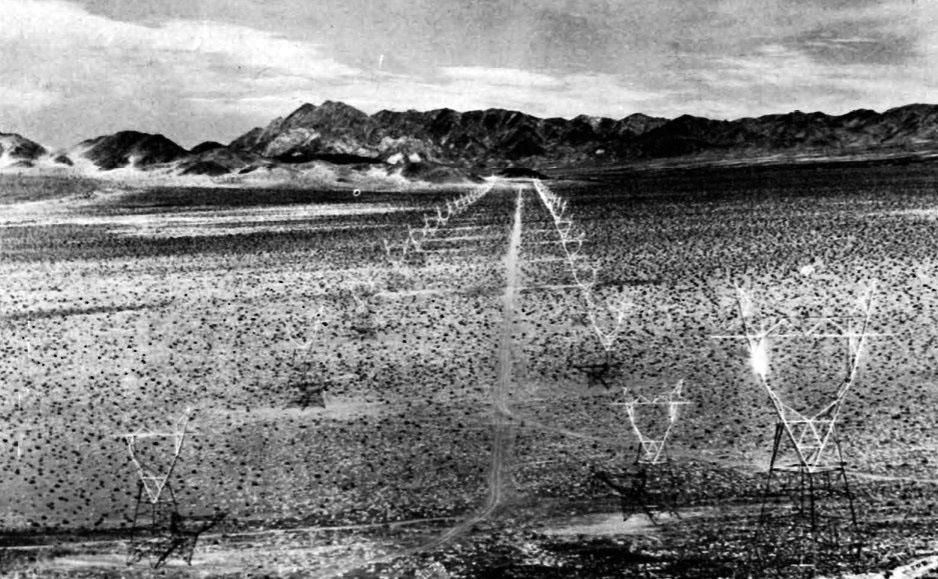 |
|
| (1933)* – Panoramic view of the Mojave Desert showing a section of the new 270-mile transmission line near Red Pass Lake. |
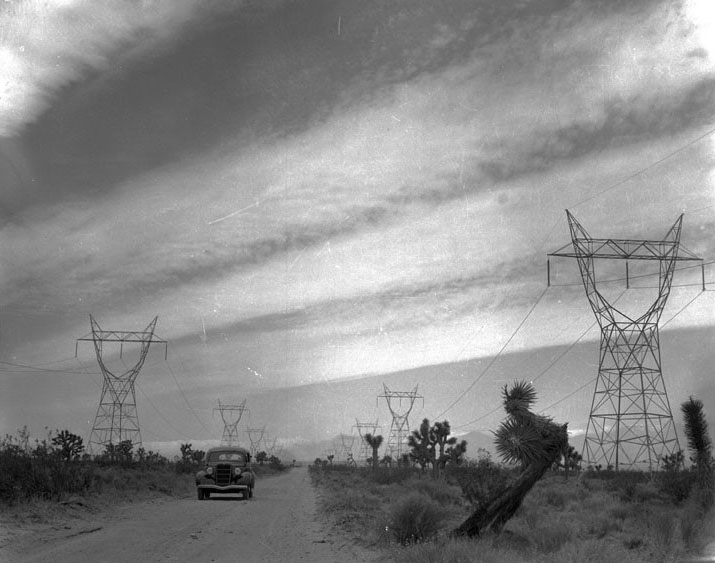 |
|
| (1935)* - View showing a car on service road between the two recently completed Boulder Transmission Lines. |
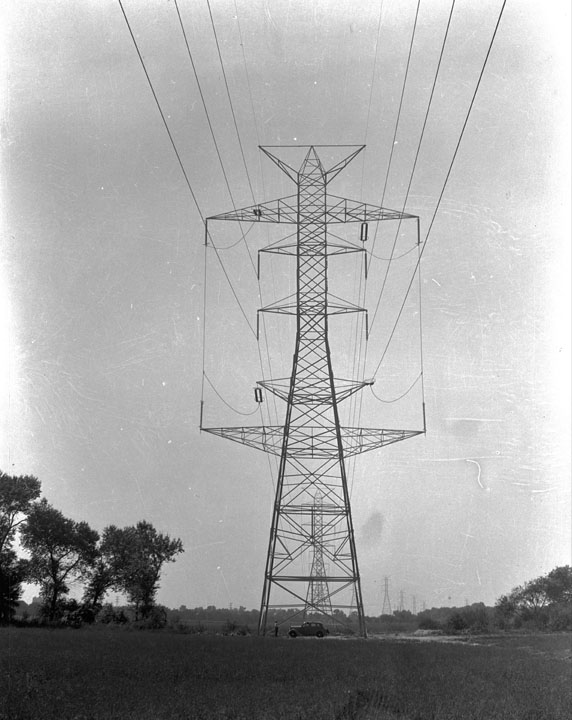 |
|
| (1935)* - Double-circuit tower on the Boulder line with early model car parked at the base. |
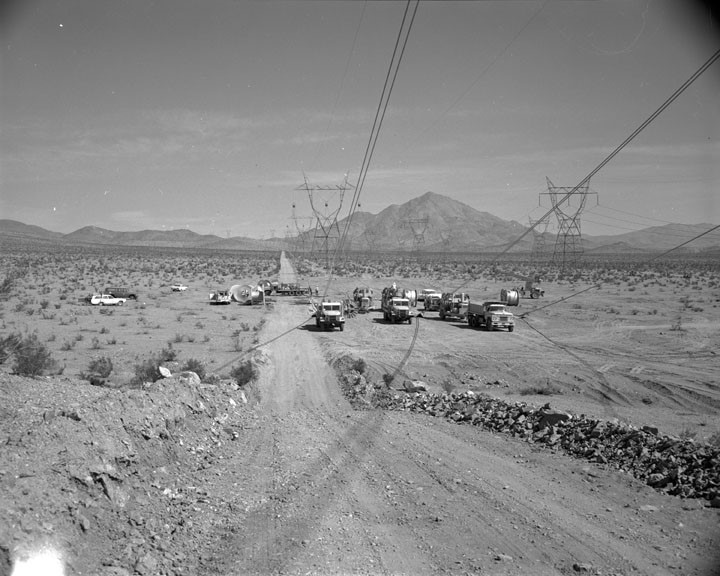 |
|
| (1969)* - Wire stringing 3rd circuit construction from Boulder line at Victorville. |
.jpg) |
|
| (1969)* - Wire stringing 3rd circuit construction from Boulder line at Victorville. |
.jpg) |
|
| (1969)* - Wire stringing 3rd circuit construction from Boulder line at Victorville. |
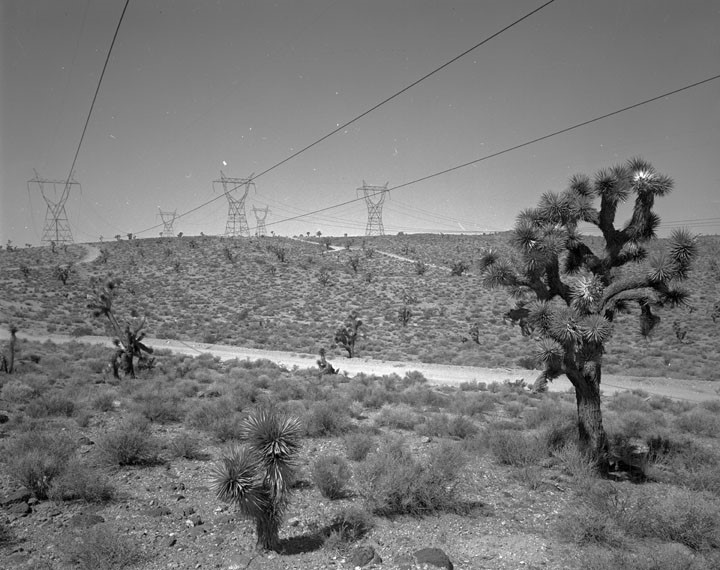 |
|
| (1969)* – View showing the Boulder transmission line crossing Mojave Desert. |
Transmission Line Equipment and Methods
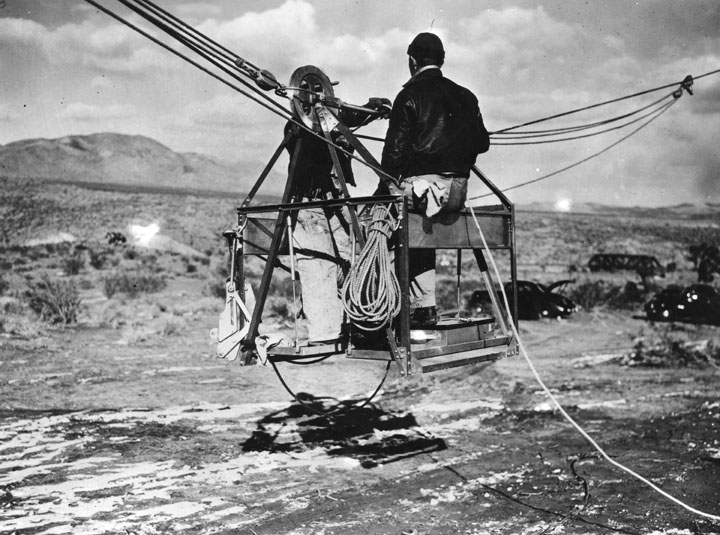 |
| One method used in making emergency splices on the boulder transmission line cable. Photo shows duralumin? car in which patrolmen are lifted to work on cables (Date unknown)* |
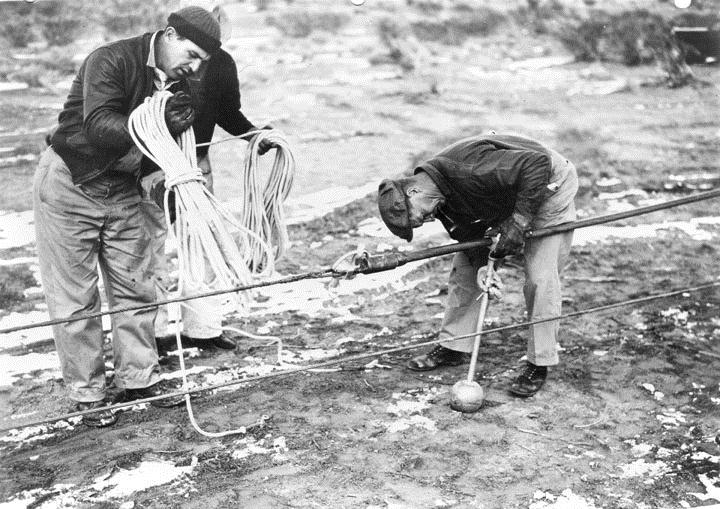 |
|
| Boulder transmission line patrolmen fastening balance weight to second section of a special clamp used in connecting loose ends of broken cable (Date unknown).* |
Transmission Line Equipment
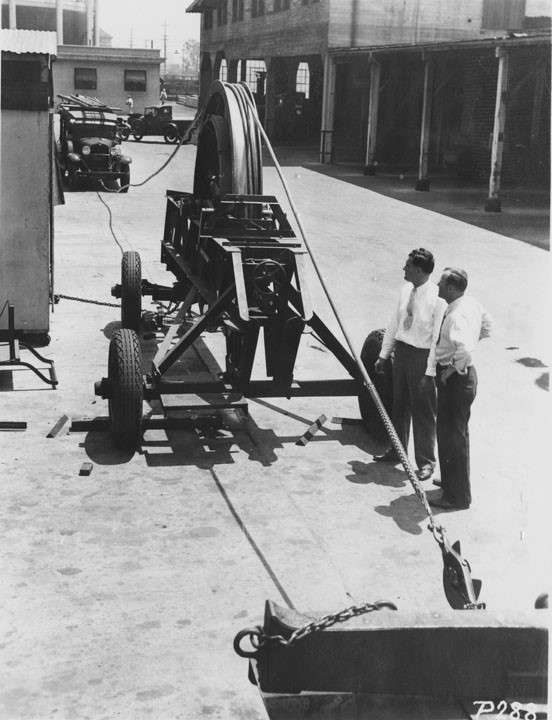 |
|
| (1934)* - A conductor braking assembly, to be used in cable stringing, is shown being tested at the 1630 North Main Street, Los Angeles, machine shop prior to its transportation to the Kingston Division of the Boulder Dam transmission line. Shown viewing the tests are left: E. J. Bown from Design and Construction Division, engineer, designer of the apparatus, and Martin F. Fleming, head machinist. |
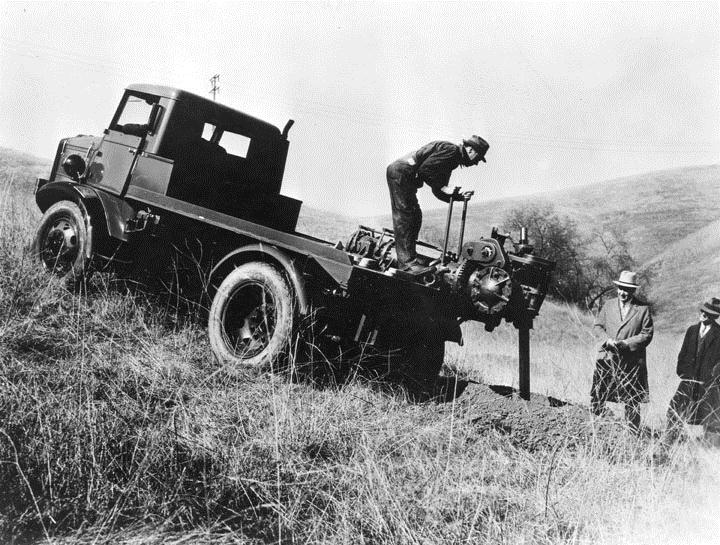 |
|
| (1930s)* - The heavy duty truck above is being tested for use by the operating division for tower line construction. Bureau of Power and Light. |
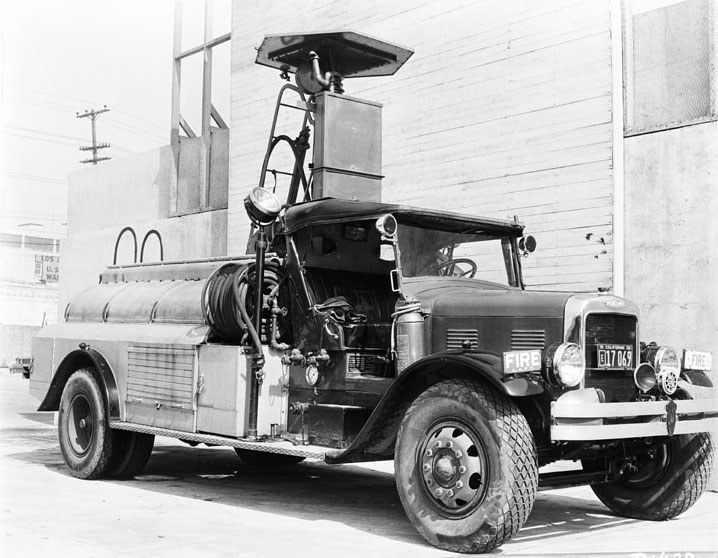 |
|
| (June 1932)* - Insulator washing truck. Caption reads: 'Fires along the right of way of the Department’s 110,000 volt transmission line and the former difficult, awkward process of cleaning dirty insulators on high tension lines now can be handled effectively through the acquisition by the Transportation Division of a combined tank truck and extension tower. |
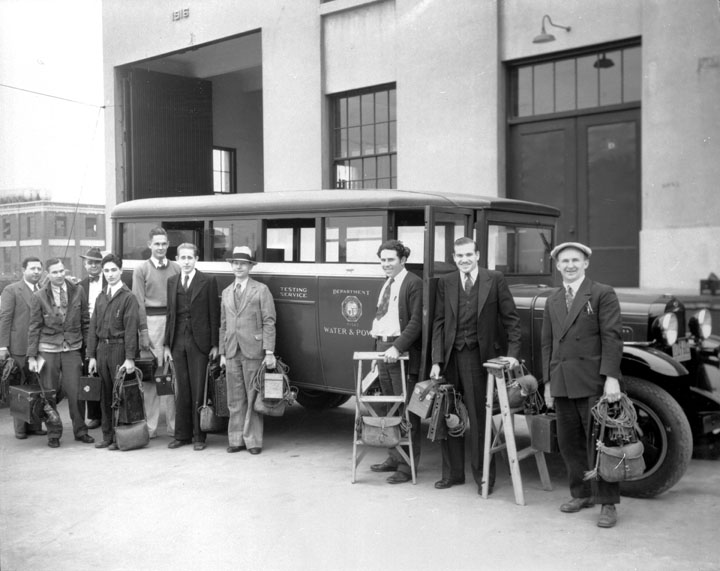 |
|
| (1930s)* - Boulder power line test crew. |
Underground Transmission Lines
The DWP is noted for many "firsts" in the electric utility industry. In 1921 the Power System installed the nation's first 33,000-volt underground line.
Between 1962 and 1968 five 230,000-volt copper cable underground transmission lines were installed. They were the first lines of such high voltage to be placed in the local underground system.
In 1969, the highest voltage aluminum cable ever to be used in an underground installation was installed along a five-mile route between the Toluca Receiving Station and the Van Nuys Receiving Station.*^
 |
|
| (February 27, 1969)* - Laying aluminum underground high voltage cable. |
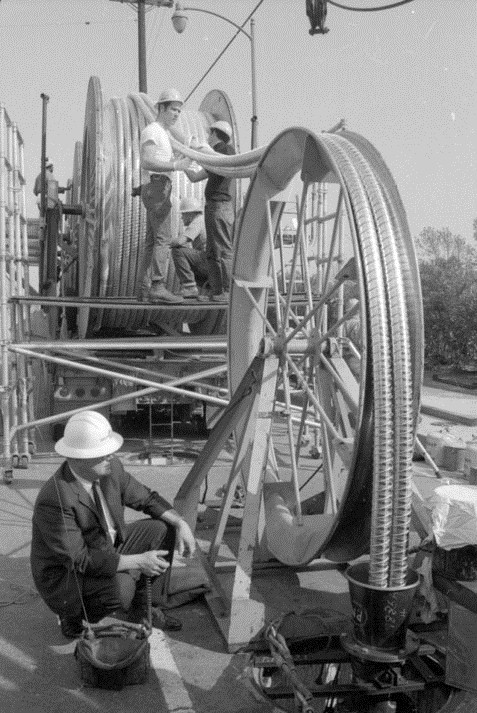 |
|
| (1969)* - Jesse R. Easterling, engineering associate in Underground Transmission Design, closely feeding of aluminum 230 kv pipe-type transmission cable as he coordinates effort via walkie talkie with pulling crew 2,000 feet away. |
Transmission Lines - Bringing Power to Los Angeles
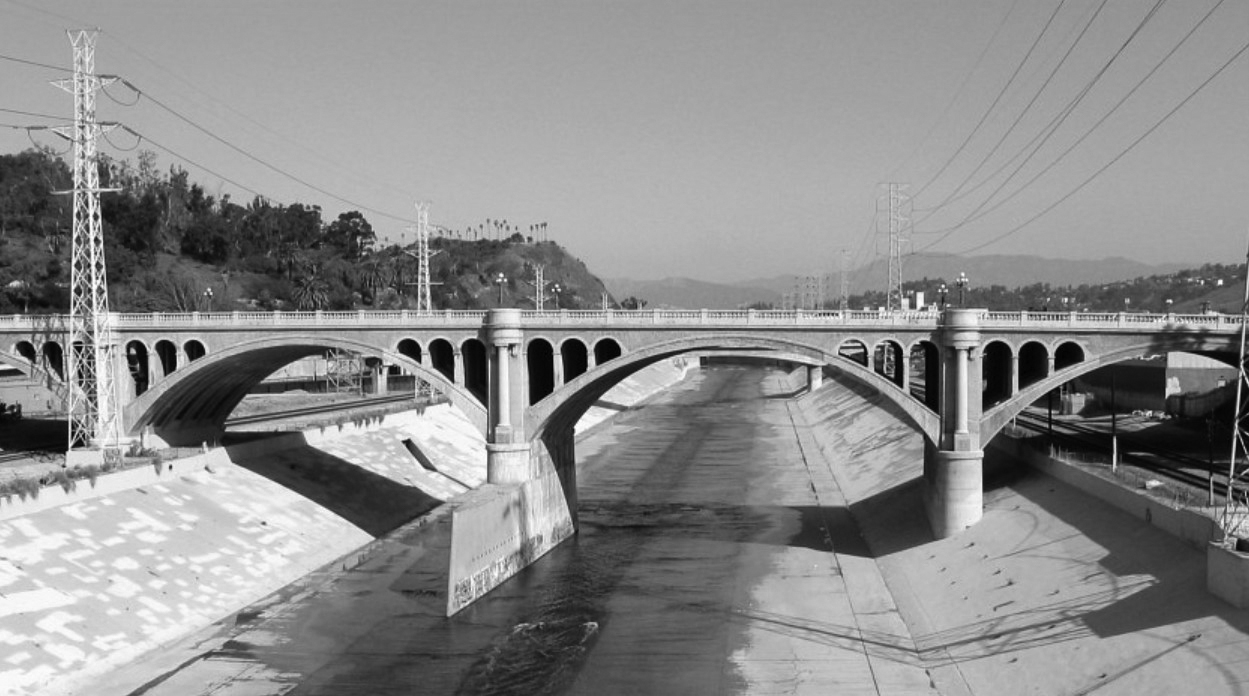 |
|
| (2000)+* - Wide-angle view of the N. Broadway Bridge looking north shortly after it was retrofitted. The concrete-lined Los Angeles River is below as it appears throughout most of the year in semi-arid Southern California. Transmission lines are seen running down both side of the river. |
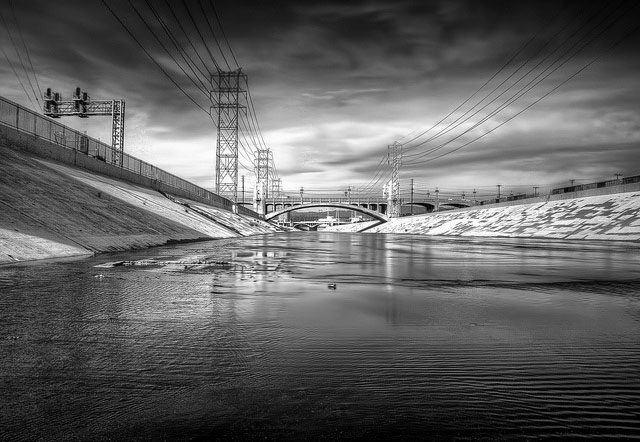 |
|
| (2013)+^ - View showing transmission lines running along both sides of the Los Angeles River with the 2nd Street Bridge seen in the background. Photo by Neil Kremer |
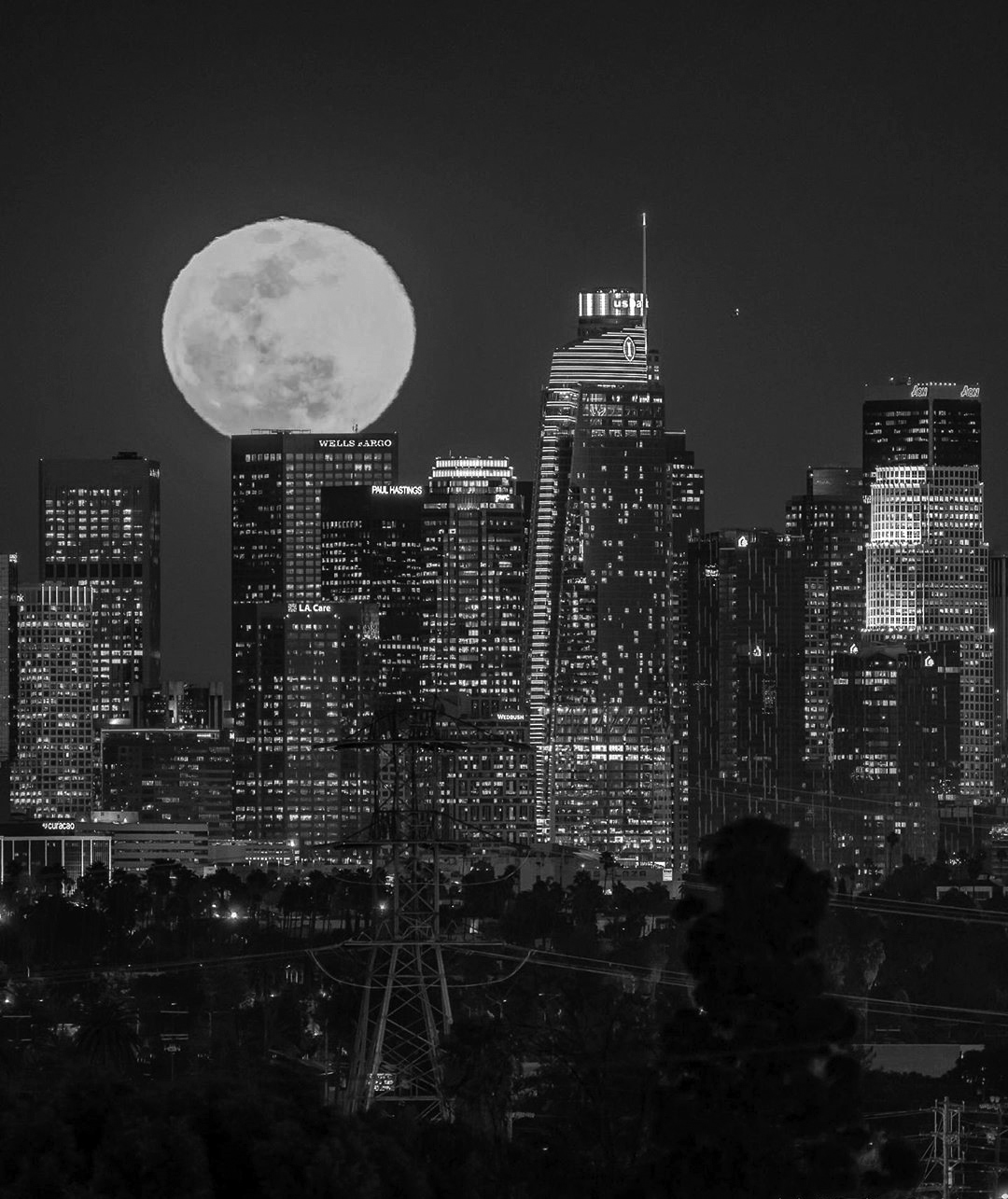 |
|
| (2019)^.^ - Downtown Los Angeles all lit up by building lights and the full moon, with transmission lines in the foreground. Photo by Phil Sutphin |
* * * * * |
History of Water and Electricity in Los Angeles
More Historical Early Views
Newest Additions
Early LA Buildings and City Views
* * * * * |
References and Credits
* DWP - LA Public Library Image Archive
^ The Boulder Canyon Project, Historical and Economic Aspects - Paul Klenscorge
**Library of Congress Digital Archive
^^Boulder Dam-LA Transmission Line Engineering Paper by E. F. Scattergood
< Back
Menu
- Home
- Mission
- Museum
- Mulholland Service Award
- Major Efforts
- Board Officers and Directors
- Positions on Owens Valley and the City of Los Angeles Issues
- Legislative Positions on
Water Issues
- Legislative Positions on
Energy Issues
- Recent Newsletters
- Historical Op Ed Pieces
- Membership
- Contact Us
- Search Index